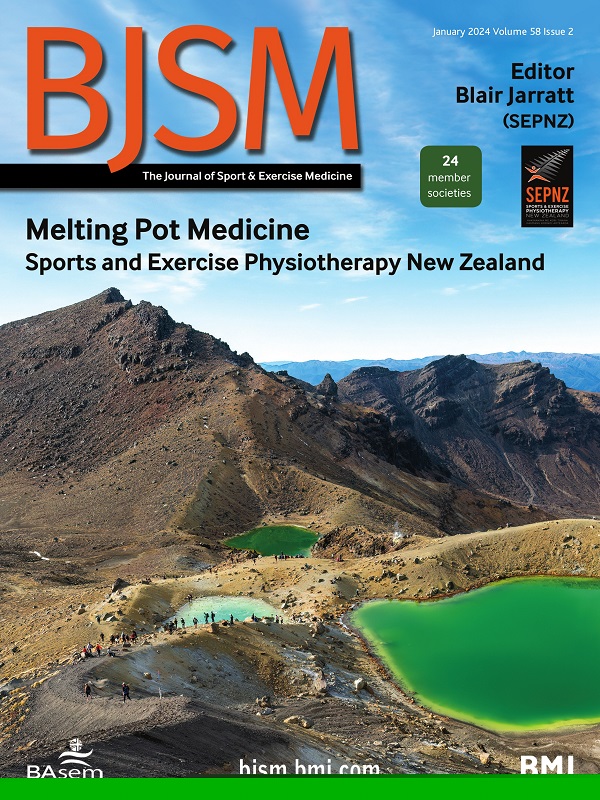下楼梯行走作为运动医学
IF 11.6
1区 医学
Q1 SPORT SCIENCES
引用次数: 0
摘要
在过去的几十年里,以迟发性肌肉酸痛和肌肉功能的长期下降为代表的肌肉损伤已经成为主要由偏心(延长肌肉)收缩(即偏心运动)组成的运动的中心议程然而,近几十年来,随着越来越多的证据表明离心运动对健康和健身参数的积极影响,特别是低强度、中等负荷的离心运动,离心运动的范式已经呈现出新的维度中等负荷的离心运动不会像高强度的离心运动那样引起肌肉损伤,但似乎会产生对健康和生活质量很重要的形态、功能和代谢适应。1-3这篇社论将讨论下楼梯行走作为一种廉价且容易获得的中等负荷偏心运动方式,以及它对健康、功能能力和身体成分的影响。最广泛研究的中等负荷偏心运动模式是偏心骑自行车,其中膝关节伸肌和髋关节伸肌抵抗由特殊设计的测力计或自行车中的马达驱动的向后移动的踏板所产生的力。一些研究已经证明了偏心循环在改善身体成分和功能能力方面的有效性。在最近的荟萃分析中,Barreto等人2证明了偏心循环增加肌肉力量和质量,功能能力和有氧能力,同时减少体脂。类似地,偏心步,即由测力计产生的直线运动而不是圆形运动,已被证明可以改善功能能力和身体成分然而,测力计的成本是这些锻炼方式的一个消极方面一种在日常生活中廉价、方便和广泛实施的方式……本文章由计算机程序翻译,如有差异,请以英文原文为准。
Descending stair walking as exercise medicine
Over the past several decades, muscle damage represented by delayed-onset muscle soreness and prolonged decreases in muscle function has been a central agenda for exercises mainly consisting of eccentric (lengthening muscle) contractions (ie, eccentric exercises).1 However, in more recent decades, the paradigm of eccentric exercise has taken on new dimensions with accumulating evidence suggesting its positive effects on health and fitness parameters, especially by low-intensity, moderate-load eccentric exercises.1 Moderate-load eccentric exercises do not induce as much muscle damage as high-intensity eccentric exercises do, but appear to produce morphological, functional and metabolic adaptations that are important for health and quality of life.1–3 This editorial will discuss descending stair walking as an inexpensive and easily accessible moderate-load eccentric exercise modality, along with its effects on health, functional capacity and body composition. The most abundantly investigated modality of moderate-load eccentric exercise is eccentric cycling,2 3 in which knee extensor and hip extensor muscles resist against the force generated by backward-moving pedals driven by a motor in a specially designed ergometer or bicycle. Several studies have demonstrated the effectiveness of eccentric cycling in improving body composition and functional capacity.2 3 In a recent meta-analysis, Barreto et al 2 documented that eccentric cycling increases muscle strength and mass, functional capacity and aerobic power, while decreasing body fat. Similarly, eccentric stepping, in which linear instead of circular movements generated by an ergometer are performed, has been shown to improve functional capacity and body composition.4 However, the cost of the ergometers is a negative aspect of these exercise modalities.3 A modality that is inexpensive, accessible and widely implementable in daily …
求助全文
通过发布文献求助,成功后即可免费获取论文全文。
去求助
来源期刊
CiteScore
27.10
自引率
4.90%
发文量
217
审稿时长
3-8 weeks
期刊介绍:
The British Journal of Sports Medicine (BJSM) is a dynamic platform that presents groundbreaking research, thought-provoking reviews, and meaningful discussions on sport and exercise medicine. Our focus encompasses various clinically-relevant aspects such as physiotherapy, physical therapy, and rehabilitation. With an aim to foster innovation, education, and knowledge translation, we strive to bridge the gap between research and practical implementation in the field. Our multi-media approach, including web, print, video, and audio resources, along with our active presence on social media, connects a global community of healthcare professionals dedicated to treating active individuals.

 求助内容:
求助内容: 应助结果提醒方式:
应助结果提醒方式:


